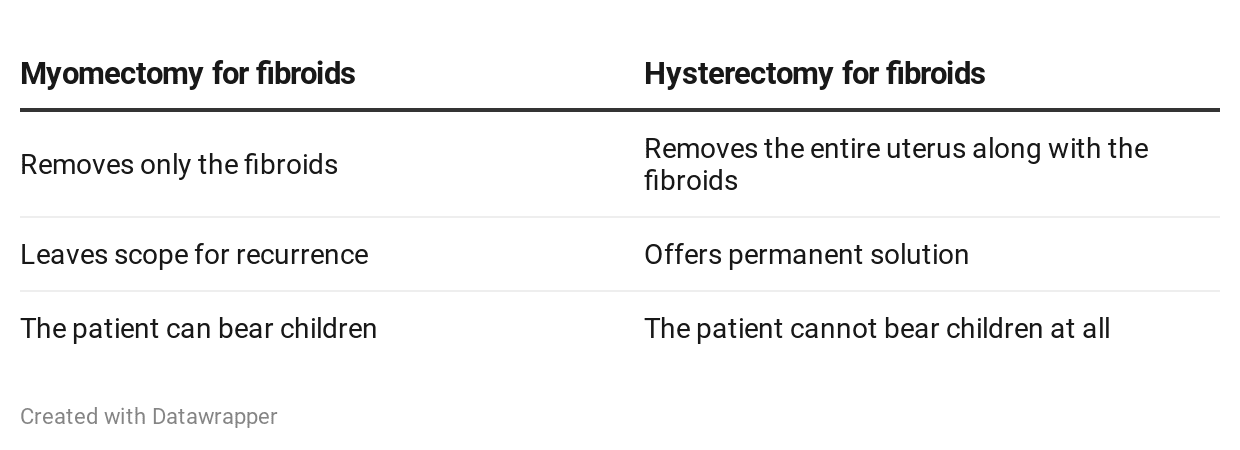
The female reproductive system is a very complex one. The conditions that can affect the fertile health of a woman are diverse. It is essential for women of childbearing age to have a basic understanding of these ailments. One of the most frequent female health concerns is the development of uterine fibroids. In this article, Dr Aruna Kalra, one of the best gynaecologist in Gurgaon, will discuss what uterine fibroids are. More so, she offers her insights on which treatment modality is better: myomectomy vs hysterectomy.
Let us begin by understanding what fibroids are all about.
Table of Contents
Uterine fibroids are growths of muscular tissues that develop in or around a woman’s uterus (womb). These growths are of different sizes; some are as small in size as chickpeas while others may grow to even cause the uterus to enlarge.
Uterine fibroids may appear a cluster of growths or as a single tumour. The size and location of uterine fibroids determine the type of symptoms a woman may experience. Some of the most common symptoms of fibroids include:
As a fibroids treatment measure, gynaecologists can offer to remove these lumps. Uterine fibroids treatment is possible by surgical and non-surgical interventions with the advent of modern scientific tools.
The appropriate fibroids treatment will depend upon several factors. Your healthcare provider will analyse your overall health, your symptoms, the size and location of the fibroids and your expectation from uterine fibroids treatment.
Usually, if the fibroid is small in size, doctors aim to treat with the use of medicines. However, surgical intervention becomes necessary in case the fibroids are large. Hysterectomy and myomectomy for large fibroids are two effective treatment options.
Uterine fibroids can be detected during your routine gynaecological screening. If you do not go for regular screening, your doctor will indicate a variety of tests if you suspect this condition.
Some of the most common diagnostic tests include:
An abdominal ultrasound scan will help your doctor in visualising the presence of abnormal growths. In case, your fibroids are not located easily through an abdominal scan, your doctor may perform a transvaginal ultrasound. In a transvaginal scan, your doctor will insert a small ultrasound probe through your vagina to see clear images of the fibroids.
A hysteroscopy is an advanced screening test in which your doctor would use a medical device called the hysteroscope. A hysteroscope is a small lighted telescope that helps in examining the inner walls of the uterus. In this procedure, your doctor would insert the hysteroscope into your womb via your vagina and cervix.
Besides these imaging tests, your healthcare provider will assess your overall health by doing regular pelvic exams, blood work, and urine tests.
Uterine fibroids can lead to severe health complications if left treated. They are often a contributing factor for infertility. There are two supreme remedy modalities – myomectomy vs hysterectomy fibroids treatment. Let us explore both of them in detail.
It is considered the frontline treatment for large fibroids. In a traditional myomectomy, the surgeon makes a large incision in the abdomen. Through this surgical incision, he/she locates the uterine fibroids and remove them. The surgeon later stitches or sews back the incision and proceeds for recovery.
There is also a more advanced method for this surgery. It is known as laparoscopic myomectomy for fibroid removal. A laparoscopic procedure is more beneficial for the patient. In this procedure, the surgeon makes several small incisions in the abdomen. He/she continues to insert a thin tube that has a tiny camera attached at one end. This tube is known as a laparoscope.
This medical device helps the surgeon to locate and visualise uterine fibroids in a better way. Through the other incisions, the surgeon removes the abnormal growths. A laparoscopic myomectomy for fibroid removal is more pain-free method. It causes less scarring and promotes quicker recovery for the patient.
A hysterectomy for fibroids is often the last resort of treatment for this condition. A hysterectomy is an invasive medical procedure in which the surgeon entirely removes the uterus from the patient’s body. This procedure is indicated to patients who have developed large fibroids inside the womb.
A hysterectomy for fibroids proves to be a permanent solution for this ailment. However, it is an irreversible process. If the uterus is removed from the reproductive system, the women cannot bear children anytime in future.
While choosing hysterectomy, the patient should carefully consider if she is willing to become pregnant in the later future. If yes, then she should not go ahead with this procedure and rather discuss other possibilities with her gynaecologist.

Myomectomy vs hysterectomy fibroid treatment is very case-specific. Both the treatment methods are highly effective and do not pose life-threatening risks. However, your overall health and expectation from the clinical outcome determine which is better for you.
To know more about uterine fibroids treatment, you can book an appointment with Dr Aruna Kalra, the Best gynaecologist at the CK Birla Hospital.